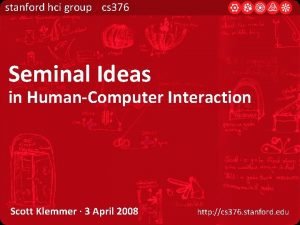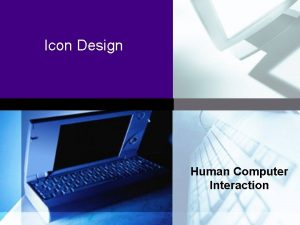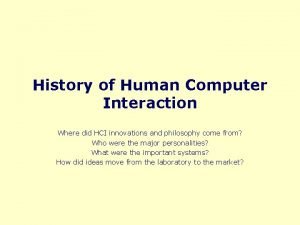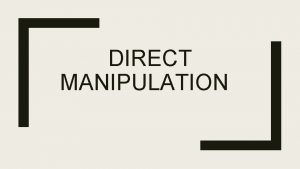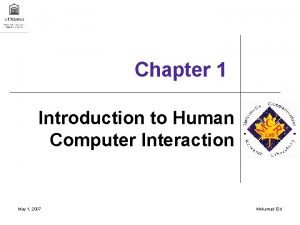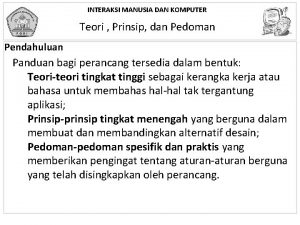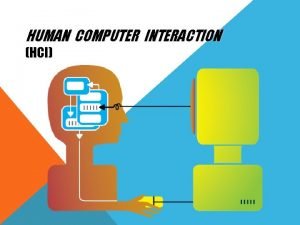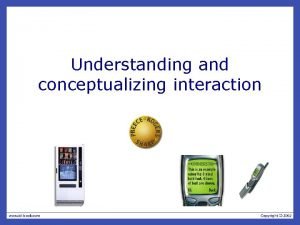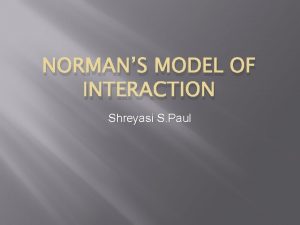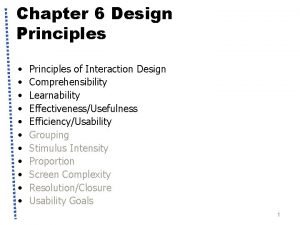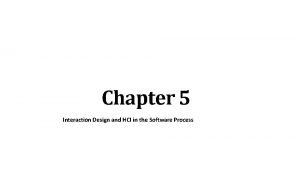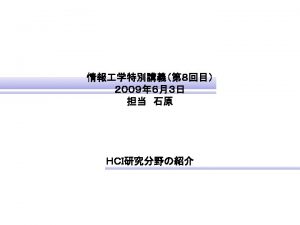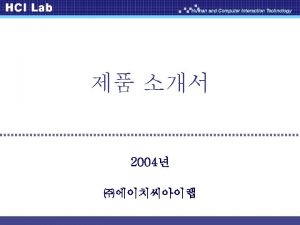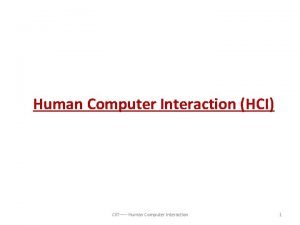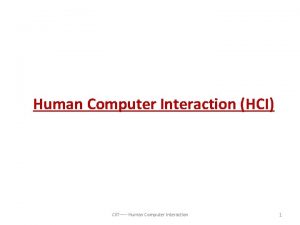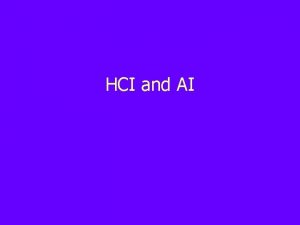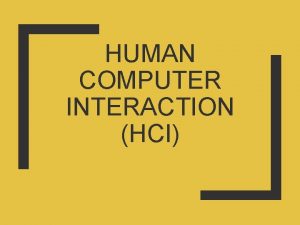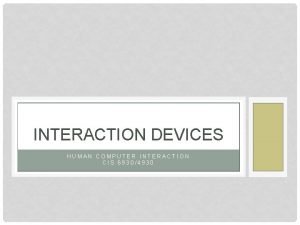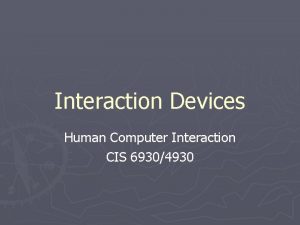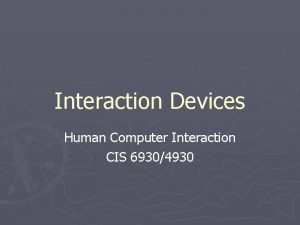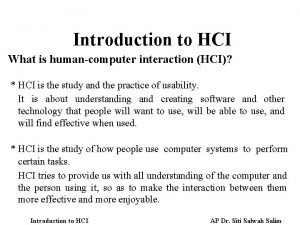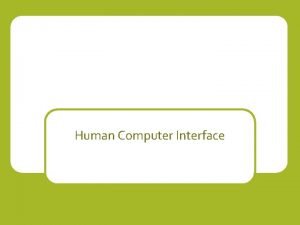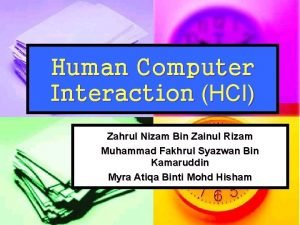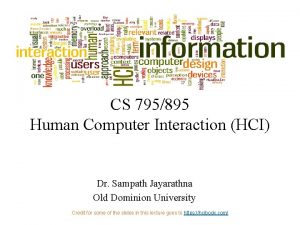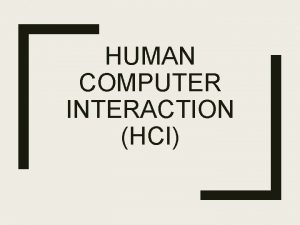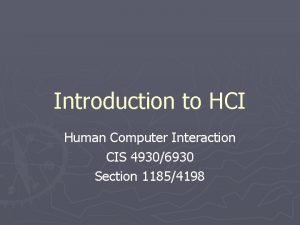Human Computer Interaction HCI Alexius Gandy Anel Jugovic






















- Slides: 22

Human Computer Interaction (HCI) Alexius Gandy & Anel Jugovic IS 6833

What are Human-Computer Interaction Systems? ● Human-computer interaction is a multidisciplinary field of study focusing on the design of computer technology and, in particular, the interaction between humans and computers. ● Incorporates computer science, human factors engineering, and cognitive science

Cont. • Human-computer interaction plays a crucial role in the way technology is built. • Google, Facebook, and Microsoft Word.

History - When? ● In 1963, Ivan Sutherland demonstrated the first use of a direct manipulation interface using a system called Sketchpad. ● William Newman created the Reaction Handler in 1966. ● Gained large popularity in the 1980 s due to the growing popularity of personal computing. ● Included machines such as Apple Macintosh, IBM 5150, & Commodore 64

History - What? ● A lot of innovation came from HCI ● Machines – Macintosh first none tiled system. Graphical interfaces. ● The mouse replaced the “Light-Pen” in 1964. ● Applications – Sketchpad, Text Editor, Spreadsheets, Hypertext, Hyperlink

WHAT IS HUMAN-COMPUTER INTERACTION? ● Communication between the human and the computer, synonymous with user interface and usability ● Similar to person-to-person interaction, where the amount of incorrectly perceived information and effort expanded by the decision maker is minimized ● Generally, the goal incorporates Computer Science, Psychology and System Design aimed at minimizing the barriers between the human’s cognitive model of what they want to accomplish and the computer’s understanding of the user’s task so that users can avail themselves of the full potential of the system (Sauter, 2011).

HUMAN-COMPUTER INTERACTION & DECISION SUPPORT SYSTEMS ● Humans (or the user) is the Decision maker and the protagonist in the jungle of technological advancement ● A system or technology can be expertly built and perform well, but ONLY to the extent that it serves the user ● The decision maker must be able to access models, data, and peruse results, invoke assistance, share results or interact with the system or it cannot provide support. Designing the user interface aims

FATHER OF INFORMATION/COMMUNICATION THEORY ● Wrote the landmark paper, The Mathematical Theory of Communication (1948), which was converged into a single fiber optic and wireless worldwide network for all types of communication ● An additional Article by Warren Weaver is contained in the book as an overview of theory for a general audience. ● Lays out the basic elements of communication:

FATHER OF INFORMATION THEORY (cont. )

CLAUDE SHANNON (1916 - 2001)

BUSINESS INTELLIGENCE SILO - PARC

FATHER OF UBIQUITOUS COMPUTING ● Coined by the head of Xerox Palo Alto Research Center (PARC) Computer Science group, Mark Weiser (1988 - 1993) ● Weiser’s vision, although difficult to articulate, was to create many, many ways to access computational capabilities (Waldrop, 1993). ● Weiser described a system in which all the devices would automatically stay in contact with the network all the time.

MARK WEISER (1952 - 1999)

MOTHER OF HCI THEORY ● Profoundly influential in helping form the nuances of ethnography in technology innovation, at PARC and across the entire field of Human-Computer interaction. ● Groundbreaking “Man vs Machine” experiment as UC Berkeley Ph. D student catapulting her career in ethnographic technology innovation (1977) ● Authored one of the first books on HCI called, “Plans and Situated Actions: The problem of human-machine communication” (1985) ● An ethnographic anthropologist researcher for Xerox Palo Alto Research Center (PARC)

LUCY SUCHMAN

LUCY SUCHMAN

DESIGN PROCESS ● Traditionally been about designing efficient and effective systems ● Well-designed interfaces can elicit good feelings in users. Badly designed interfaces make people angry and frustrated ● Emotional interaction is concerned with how we feel and react when interacting with technologies ● Aesthetically pleasing and rewarding interfaces will increase positive affect.

DESIGN: PROVIDE FEEDBACK ● INFORM THE USER ABOUT: ○ What it is doing ○ How it is interpreting the user’s input ○ User should always be aware of what is going on

DESIGN (cont. ) ● INFORM THE USER ABOUT: ○ User interface should be designed to match the skills, experience and expectations of its anticipated users ○ Users often judge a system by its interface rather than its functionality ○ Designers should be aware of people’s physical and mental limitations and should recognize user mistakes

REFERENCES (cont. ) Sauter, V. L. (2011). Decision support systems for business intelligence. Wiley-Blackwell (an imprint of John Wiley & Sons Ltd). Darejeh, A. , & Singh, D. (2014, 09). An investigation on Ribbon interface design guidelines for people with less computer literacy. Computer Standards & Interfaces, 36(5), 808 -820. doi: 10. 1016/j. csi. 2014. 01. 006 Xerox Digital Printing. “Top Takeaway from PRINT '17. ” Xerox, 21 Nov. 2017, www. xerox. com/en-lu/digitalprinting/insights/printing-business-evolution Weiser, M. (1991, 09). The Computer for the 21 st Century. Scientific American, 265(3), 94 -104. doi: 10. 1038/scientificamerican 0991 -94 Waldrop, M. M. (1993, 09). PARC Builds a World Saturated With Computation. Science, 261(5128), 1523 -1524. doi: 10. 1126/science. 261. 5128. 1523 Miller, G. A. (2003, 03). The cognitive revolution: A historical perspective. Trends in Cognitive Sciences, 7(3), 141 -144. doi: 10. 1016/s 1364 -6613(03)00029 -9

REFERENCES Want, R. , Pering, T. , Borriello, G. , & Farkas, K. (2002, 01). Disappearing hardware [ubiquitous computing]. IEEE Pervasive Computing, 1(1), 36 -47. doi: 10. 1109/mprv. 2002. 993143 Weiser, M. , Gold, R. , & Brown, J. S. (1999). The origins of ubiquitous computing research at PARC in the late 1980 s. IBM Systems Journal, 38(4), 693 -696. doi: 10. 1147/sj. 384. 0693 PARC (2011). Busting the Myth of the Giant Green Button. Retrieved from https: //uxmag. com/articles/busting-the-myth-of-the-giantgreen-button “Ethnography and the PARC Copier. ” You. Tube, 22 Dec. 2016, youtu. be/DUw. XN 01 ARYg Sutherland, I. E. “Sketch. Pad: A Man-Machine Graphical Communication System, ” in AFIPS Spring Joint Computer Conference. 1963. 23. pp. 329 -346. (3) Newman, W. M. “A System for Interactive Graphical Programming, ” in AFIPS Spring Joint Computer Conference. 1968. 28. pp. 4754. (4)

QUESTIONS? For a Copy of this Presentation
 Gamna gandy bodies
Gamna gandy bodies Jovana jugovic ekof
Jovana jugovic ekof Stanford hci
Stanford hci Icon in hci
Icon in hci Impersonal computing
Impersonal computing Input output channels
Input output channels History of human computer interaction
History of human computer interaction Concept of direct manipulation in hci
Concept of direct manipulation in hci Hci chapter 1
Hci chapter 1 Uhcd adalah
Uhcd adalah Yang termasuk model antarmuka objek-aksi
Yang termasuk model antarmuka objek-aksi Human computer interaction syllabus
Human computer interaction syllabus Model konseptual
Model konseptual Alan dix
Alan dix Human computer interaction diagram
Human computer interaction diagram Ergonomics in human computer interaction
Ergonomics in human computer interaction Definition of human computer interaction
Definition of human computer interaction Interaction styles in hci
Interaction styles in hci Don norman 7 stages of action
Don norman 7 stages of action Rich interaction
Rich interaction Comprehensibilty
Comprehensibilty Hci design process
Hci design process Emotional interaction
Emotional interaction


